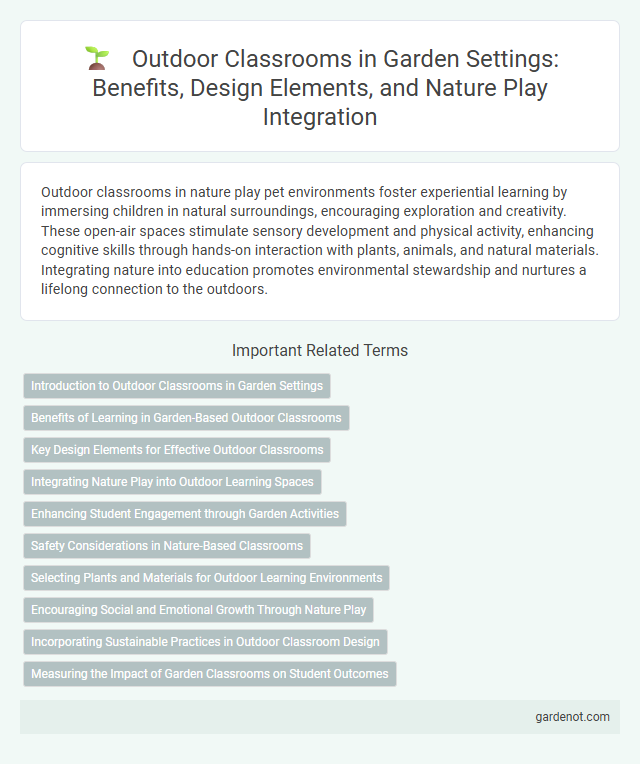Outdoor classrooms in nature play pet environments foster experiential learning by immersing children in natural surroundings, encouraging exploration and creativity. These open-air spaces stimulate sensory development and physical activity, enhancing cognitive skills through hands-on interaction with plants, animals, and natural materials. Integrating nature into education promotes environmental stewardship and nurtures a lifelong connection to the outdoors.
Introduction to Outdoor Classrooms in Garden Settings
Outdoor classrooms in garden settings enhance experiential learning by integrating natural elements such as plants, soil, and wildlife habitats into the curriculum. These environments support sensory engagement and promote environmental stewardship among students. Effective garden-based outdoor classrooms foster hands-on activities that improve critical thinking, collaboration, and physical health.
Benefits of Learning in Garden-Based Outdoor Classrooms
Learning in garden-based outdoor classrooms enhances student engagement by providing hands-on experiences that foster curiosity and critical thinking. Exposure to natural environments supports cognitive development and reduces stress, promoting better focus and emotional well-being. Studies show that garden-based education improves academic performance in science, math, and environmental literacy through active, experiential learning.
Key Design Elements for Effective Outdoor Classrooms
Key design elements for effective outdoor classrooms include natural seating arrangements such as logs, stumps, or stone benches that blend seamlessly with the environment and encourage student interaction. Incorporating diverse plant life and sensory gardens enhances hands-on learning and stimulates curiosity about local ecosystems. Strategic placement of shade structures and permeable surfaces ensures comfort and environmental sustainability while allowing for flexible usage throughout various weather conditions.
Integrating Nature Play into Outdoor Learning Spaces
Integrating nature play into outdoor learning spaces enhances children's cognitive and physical development by fostering creativity and problem-solving through hands-on interactions with natural elements. Designing these classrooms with diverse plantings, natural materials, and sensory-rich environments supports experiential learning and environmental stewardship. Outdoor classrooms that incorporate nature play encourage social collaboration and promote mental well-being by connecting students to the natural world.
Enhancing Student Engagement through Garden Activities
Outdoor classrooms that incorporate garden activities significantly boost student engagement by fostering hands-on learning and sensory experiences. Participating in planting, watering, and observing growth cultivates responsibility and curiosity, leading to improved focus and collaboration among students. Studies show that garden-based learning enhances cognitive development and promotes environmental stewardship in young learners.
Safety Considerations in Nature-Based Classrooms
Ensuring safety in nature-based classrooms involves thorough risk assessments of natural elements, including uneven terrain, water bodies, and local wildlife, to prevent accidents and allergies. Proper supervision ratios and clear safety protocols, such as designated play zones and emergency procedures, are critical for minimizing hazards during outdoor activities. Using durable, non-toxic materials for equipment and providing weather-appropriate clothing guidelines further enhance child safety in outdoor learning environments.
Selecting Plants and Materials for Outdoor Learning Environments
Selecting native, non-toxic plants enhances safety and ecological relevance in outdoor classrooms, fostering biodiversity and engaging students with local ecosystems. Durable, weather-resistant materials like recycled plastic, treated wood, and natural stone ensure longevity and low maintenance while providing tactile learning experiences. Incorporating sensory-rich elements such as fragrant herbs and textured bark supports multisensory exploration, critical for hands-on nature-based education.
Encouraging Social and Emotional Growth Through Nature Play
Outdoor classrooms foster social and emotional growth by immersing children in natural settings that promote collaboration, empathy, and self-regulation. Nature play encourages peer interaction, problem-solving, and communication skills by engaging learners in shared tasks and unstructured exploration. This environment supports emotional resilience and reduces stress, creating a foundation for holistic development in early childhood education.
Incorporating Sustainable Practices in Outdoor Classroom Design
Incorporating sustainable practices in outdoor classroom design enhances environmental stewardship and fosters hands-on learning about nature. Using reclaimed materials, native plants, and renewable energy sources reduces ecological impact and creates resilient learning spaces. Proper site selection and natural shading improve energy efficiency while promoting biodiversity and student well-being.
Measuring the Impact of Garden Classrooms on Student Outcomes
Garden classrooms in outdoor education settings demonstrate significant improvements in student engagement, academic performance, and social-emotional skills. Studies reveal that exposure to nature-based learning environments enhances attention spans, reduces stress levels, and fosters collaboration among students. Measuring these outcomes involves quantitative assessments of test scores, behavioral observations, and qualitative feedback from educators and students.
Outdoor Classroom Infographic

 gardenot.com
gardenot.com